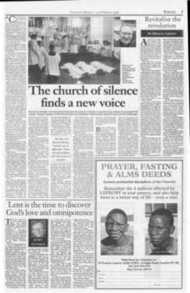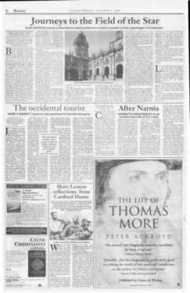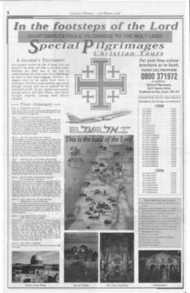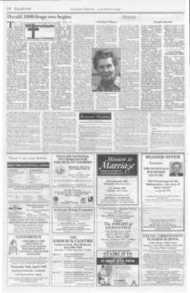Page 6, 13th March 1998
Page 6

Report an error
Noticed an error on this page?If you've noticed an error in this article please click here to report it.
Tags
Share
Related articles
Field Of Spanish Stars
A Spain
Under The Gaze Of St James
Joyful Serenity Greets Pilgrims To Santiago De Compostela
Liverpudlians Cycle For Youth Ministry
Journeys to the Field of the Star
ELISA SEGRAVE follows a seventeenth-century priest and a modern novelist on their pilgrimages to Compostela
The Field of the Star: A pilgrim's journey to Santiago de Compostela by Nicholas Luard, Michael Joseph, £17.99 A Journey to the West: the diary of a 17th century pilgrim from Bologna to Santiago de Compostela, by Domenico Laffi, translated with a commentary by James Hall, Primavera Press, Leiden
B(T11 1 "11-1FSE WET MRS, more than three centuries apart, love travel. Domenico Lafti, born in the foothills of the Italian Apennines near Bologna in 1636, journeyed to Spain four or five times and once went to the Holy Land. He preferred these arduous treks to the duties of a parish priest. In this diary of his pilgrimage from Bologna to Santiago de Compostela (the Spanish spelling of Compostela has one "1", as opposed to the Italian two), he hardly ever complains of exhaustion or ill-health and is not phased by some of the worse sights on the way. He encounters two dead pilgrims: the first, near the Spanish town of Castrojeriz, is about to be eaten by locusts and the second, several leagues on, is already being devoured by wolves. Laffi and his companion, Domenico Codici, a painter, make do each night with the "pasada" the obligatory alms/food handed out to pilgrims. Depending on the wealth of the town or village, this is sometimes just a piece of rough bread. Lassi, fascinated by different customs, tells how, in the foothills of the Pyrenees, near St Jean Pied de Port, there is a shortage of wine so vinegar added to water is drunk instead. Nicholas Lund, a professional author of 60, has also done his share of wandering. He has written travel books on the Kalahari Desert and on Andalucia, besides several novels. In their 20s, he and his wife Elizabeth eschewed their trendy London life Luard was a founder of the Establishment Club and of Private Eye and a friend of Peter Cook and took their four tiny children to live first in Andalucia then in the Languedoc.
Neither of these two pilgrim-authors is conventional The Italian priest Laffi is fascinated by architecture, relics, local customs and miracles, in which he believes whole-heartedly, even the one related to him outside Avignon, concerning St Benedict, in which a child's head was allegedly turned back to front when it told a lie. As befits his priestly station, Laffi says many Masses along the way and his era is the Counter-Reformation expresses strong disapproval of "heretics". Morlaas, a town between Toulouse and Roncesvalles, (where Roland sounded his horn) he dubs "the entrance to the very house of the Devil... all heretics here and not a Catholic among them. When we saw so much of the Devil's work, on no account would we pass through the town so we came out of the gate again..."
Three centuries later, Luard is reluctant to share a hotel with Germans. He disapproves of the EEC, with its policy of "paying good people to grow things; paying them to harvest them; and then paying them to destroy them". He is also horrified by the heaps of discarded apples in the apple-orchards near Cajarc
in France, He also loathes political correctness.
"We have lost ability to wonder and learn... We tell the "Eskimos" to stop hunting the whales when most of us wouldn't recognise an Inuit if we woke up to find one in our bed."
Unlike Lath, Luard is not very interested in architecture. His book is not as learned as the priests diary, but it does
not pretend to be. Also, Laffi's diary benefits enormously from its translator James Hall's informed commentary and notes, besides excellent photographs of churches, statues, water-wheels, paintings etc. It was out of print for nearly two centuries until this attractive new edition.
James Hall also tries scrupulously to get to the source of the Compostela legend, explaining that in 830 a tomb
was discovered under what is now Compostela Cathedral, but was then just a wooded hillside. The tomb was probably a Roman burial chamber which then became the centre of a local cult, possibly Christian. The grounds for supposing that the contents of the tomb were the remains of the apostle James the Greater are flimsy.
Luard, a romantic, prefers the legend. The body of St James, a disciple of Christ, whom Luard refers to as "the carpenter's son", was taken in a stone boat to Spain where James had already been teaching the Gospel. 'l'he disciple's body was then buried in a field Compostela, the field of the Star. The cathedral was later built on the site.
As a reader, I sometimes found Laffi a little bland and repetitive and too like a travel guide. Luard is more entertaining, partly because he is not afraid of anecdotes in which he appears undignified. He tells how, in the pilgrim gire of Montgros, he ended up sharing a dormitory with 15 women, 13 of them Swiss tax inspectors, members of a ladies' cycling club from Grenoble: the other two his sister Priscilla and her friend Hilary, his companions during most of the pilgrimage, which they undertook in separate stints over a period of three years.
Luard's book also has an important extra dimension. His eldest daughter, Francesca, was dying of AIDS. This was one impetus for his journey. The chapters about her are astonishingly moving and honest and must have been painful to write. He and she had a tempestuous relationship and, with exemplary humil
my, he does not stint from admitting his shortcomings as a father. In an early chapter he recalls how, aged 13, she handed him an envelope on his birthday.
"Inside was my birthday present a worn ki note. I looked up and saw you watching me steadily with your damsondark eyes, so dark they were almost black. I was humiliated and embarrassed, but I Raid nothing.. "
He realised with shame how on het birthdays he had usually casually reached into his pocket and given her cash instead of a carefully-chosen present.
"You wanted something from me and 1 hadn't measured up."
Francesca died in St Thomas's Hospital in 1995 with most of her family present.
Later Luard describes Francesca, aged nine, on an earlier pilgrimage, with him, to the Rocio .irgin, the "white dove of the marshes" of the Guadalquivir river, south-west of Seville. During the five-day Whitson fiesta the little girl danced with the local Spanish women, "the elegant formal patterns of the Sevilla arabesques..."
" 'Ai, que gracia!' the Sevilla ladies called as they clapped their hands in rhythm while you turned and shaped your wrists into swans' necks and snapped your fingers to the guitars and castanets."
Luard's love of Spain, and his more complex, difficult love and admiration for his daughter, is what comes across most strongly in The Field of the Star. A brave book.
blog comments powered by Disqus













